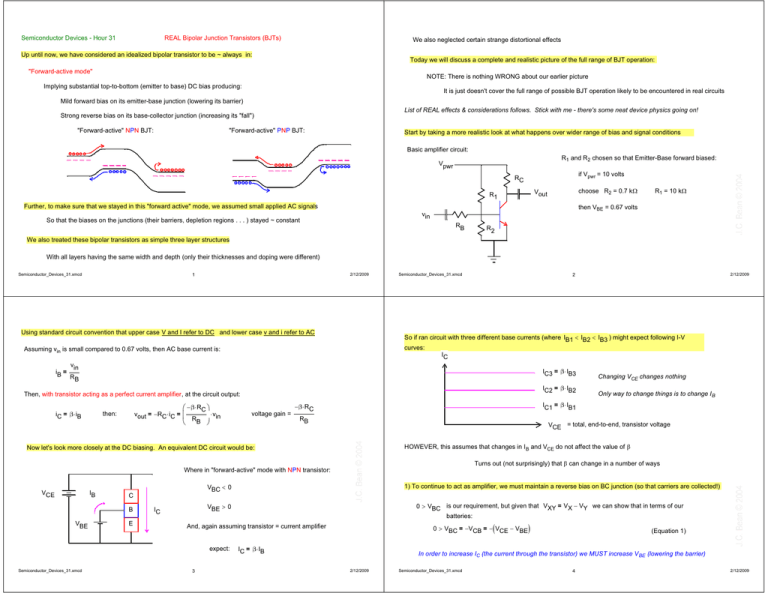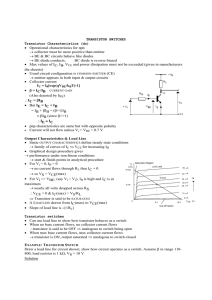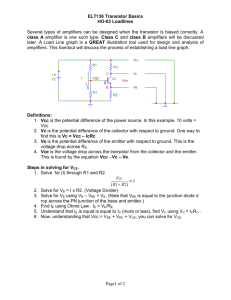PDF/4
advertisement

Semiconductor Devices - Hour 31 REAL Bipolar Junction Transistors (BJTs) We also neglected certain strange distortional effects Up until now, we have considered an idealized bipolar transistor to be ~ always in: Today we will discuss a complete and realistic picture of the full range of BJT operation: "Forward-active mode" NOTE: There is nothing WRONG about our earlier picture Implying substantial top-to-bottom (emitter to base) DC bias producing: It is just doesn't cover the full range of possible BJT operation likely to be encountered in real circuits Mild forward bias on its emitter-base junction (lowering its barrier) List of REAL effects & considerations follows. Stick with me - there's some neat device physics going on! Strong reverse bias on its base-collector junction (increasing its "fall") "Forward-active" NPN BJT: "Forward-active" PNP BJT: Start by taking a more realistic look at what happens over wider range of bias and signal conditions Basic amplifier circuit: R1 and R2 chosen so that Emitter-Base forward biased: Vpwr if Vpwr = 10 volts RC choose R2 = 0.7 k: Vout R1 Further, to make sure that we stayed in this "forward active" mode, we assumed small applied AC signals then VBE = 0.67 volts vin So that the biases on the junctions (their barriers, depletion regions . . . ) stayed ~ constant R1 = 10 k: RB R2 We also treated these bipolar transistors as simple three layer structures With all layers having the same width and depth (only their thicknesses and doping were different) Semiconductor_Devices_31.xmcd 2/12/2009 1 Using standard circuit convention that upper case V and I refer to DC and lower case v and i refer to AC vin RB IC3 = β IB3 IC2 = β IB2 Then, with transistor acting as a perfect current amplifier, at the circuit output: iC = β iB § β RC · vout = RC iC = ¨ vin ¨ RB © ¹ then: voltage gain = 2/12/2009 2 So if ran circuit with three different base currents (where IB1 IB2 IB3 ) might expect following I-V curves: IC Assuming vin is small compared to 0.67 volts, then AC base current is: iB = Semiconductor_Devices_31.xmcd Changing VCE changes nothing Only way to change things is to change I B IC1 = β IB1 β RC RB VCE = total, end-to-end, transistor voltage HOWEVER, this assumes that changes in I B and VCE do not affect the value of E Now let's look more closely at the DC biasing. An equivalent DC circuit would be: Turns out (not surprisingly) that E can change in a number of ways Where in "forward-active" mode with NPN transistor: VCE IB B VBE E 0 ! VBC is our requirement, but given that VXY = VX VY we can show that in terms of our batteries: VBE ! 0 IC And, again assuming transistor = current amplifier expect: Semiconductor_Devices_31.xmcd 1) To continue to act as amplifier, we must maintain a reverse bias on BC junction (so that carriers are collected!) VBC 0 C 3 0 ! VBC = VCB = VCE VBE IC = β IB (Equation 1) In order to increase IC (the current through the transistor) we MUST increase V BE (lowering the barrier) 2/12/2009 Semiconductor_Devices_31.xmcd 4 2/12/2009 · § q VBE ¨ kT IC ~ IBE = Isat © e 1¹ But as VBE increases in, equation above, will reach a point where V BE > VCE then sign flips At that point (and for higher currents) we no longer have reverse biased collector > lose gain Forward active: inverting this: k T §¨ Ic · VBE = ln ¨ Isat q © ¹ Inserting this into equation 1, above: § k T §¨ Ic · · 0 ! VBC = ¨ VCE ln ¨ ¨ Isat q Not forward active: © © ¹¹ => This inequality is violated (and transistor stops operating a current amplifier with gain E) when: By lowering barrier in middle (to get more IC) We've lost reverse bias on right BC junction q VCE k T §¨ Ic · ln ! VCE ¨ Isat q © or rearranging, will loose normal operation when: ¹ kt Leading to a revised set of I-V curves (each for a different base current): And it can now start to backward inject! IC We can calculate this changeover by analyzing the emitter-base diode β IB3 § q VBE · ¨ kT IBE = Isat © e 1¹ For the forward biased E-B diode: IC ! Isat e LEFT of the dashed exponential we have lost the β IB2 β IB1 reverse bias on the base-collector junction But for a narrow-base transistor, this current across the E-B junction is ~ the current across the B-C junction: VCE Semiconductor_Devices_31.xmcd 2/12/2009 5 Higher base currents = higher current through the device => more voltage needed on emitter base junction Semiconductor_Devices_31.xmcd IC IC = β ( n 1) ∆IB β ( n) ∆IB = β ∆IB n 1 n Then: 2/12/2009 6 Spacing between curves is D current gain => Less of power supply voltage left over for base-collector reverse bias Constant gain = Uniform spacing: Decreasing gain = Decreasing spacing: => REASON dashed line is farther right for higher currents IC IC Add to this the knowledge that if V CE => 0 expect NO current through the device - and connect the points: IC IC3 = β IB3 VCE IC2 = β IB2 IC1 = β IB1 VCE What sort of things (far from saturation on left) might lead to changes in current gain? "Base Width Modulation" VCE VBE = E-B forward bias "Forward-Active" Amplifying Mode = small value "Saturation" = So much current (used so much voltage on EB junction) VCE IB that no longer have enough voltage left to hold B-C junction in reverse bias B VBE Machine that produces these curves, typically steps up the base current by equal amounts between curves: IB1 = ∆IB Semiconductor_Devices_31.xmcd IB2 = 2 ∆IB IB3 = 3 ∆IB 7 C E = held ~ constant by VBE (or R1 and R2) IC THUS increasing VCE means base-collector reverse bias must be increasing ... 2/12/2009 Semiconductor_Devices_31.xmcd 8 2/12/2009 Looks like extrapolations of straight line segments might converge to left: Means B-C depletion width must increase: IC VBC = VR VBE Emitter Collector xB_eff WBC = 2 κ εo Vbi VR § 1 1 · ¨ q © NB NC ¹ VCE VEarly Point of approximate convergence = "Early Voltage" after James Early of Fairchild Semiconductor More VCE => more voltage across B-C junction => Wider B-C depletion layer => Narrower effective base width (very nice guy, met him several times) As effective base width shrinks, less recombination => increase in gain, thus expect: Ideal transistor (no slopes, as early in this lecture): VEarly = ∞ IC Real transistor: VEarly is finite (but the larger the better) To increase Early voltage (decrease effect of base-width modulation) by making base thicker: - Depletion makes less of a percentage change in base width VCE Semiconductor_Devices_31.xmcd - But this decreases the transistor's E! 2/12/2009 9 Semiconductor_Devices_31.xmcd 2/12/2009 10 B-C Junction Avalanche Breakdown Why care about that slight slope in the curves (=slight increase in E as VCE increases)? Similar to the avalanche breakdown of a simple diode - except transistor AMPLIFIES the effect! "Base-width modulation" / "Early Effect" distorts the amplification of signals! Base Emitter Apply input AC signal (here a triangular wave) to the base of an NPN transistor: - Negative voltage swing => Increase VBC, increase WBC, increase E VBC C B - Positive voltage swing => Decrease VBC, decrease WBC, decrease E vin: Collector VBE E vout: Hole drifting across B-C junction loses energy Energy creates new electron-hole pair After: Before: Then NEW carriers can do the same thing => Avalanche How does this differ from simple diode avalanche breakdown? Distortion, harmonics . . . Large number of avalanche holes produced flow into base => Charge base slightly more positive Other non-ideal effects: => Lowers Emitter-Base barrier turning transistor more strongly on! Semiconductor_Devices_31.xmcd 11 2/12/2009 Semiconductor_Devices_31.xmcd 12 2/12/2009 Step 1) New hole produced Step 2) Holes accumulate in base charging it more positive Step 3) Lowered E-B barrier => massive current Loss of "Low-Level Injection" - A reason why gain tends to decrease as transistor is driven hard: Normal "Low-Level Injection" (remember, low-level injection = ~ no change in majority carrier population) ppo No change in holes!!! Base region of NPN: np Transistor AMPLIFIES the effect of the beginning avalanche: npo Avalanche multiplication is thus important at voltages lower than one expects from simple diode Breakdown voltage of transistor BC junction ~ Breakdown voltage of comparable diode Emitter Side β Manifestation of B-C avalanche breakdown in I-V curves: Collector Side High-Level Injection (transistor really strongly on): IC <= Electron buildup pulls in extra holes = More holes trying to jump into emitter BVceo = Breakdown voltage common emitter . . . = These holes must be replaced by IB Strong accumulation of negative electrons at emitter side of base = Less gain in transistor! VCE BVceo Semiconductor_Devices_31.xmcd 2/12/2009 13 I-V Manifestation (as shown early in lecture): Semiconductor_Devices_31.xmcd 2/12/2009 14 At High VCE, depletion layer of BC junction actually CONNECTS with depletion layer of EB junction: IC Bands no longer rise as far in base => Massive increase in current ( I-V similar to avalanche breakdown) Higher drive => Smaller intervals between curves => Reduced gain To these effects (and a couple of others I didn't go into), must add: VCE Actual 3D configuration of bipolar transistor (here a big power transistor): Base Contact "Punch Through" - Another thing that can go wrong if drive transistor too hard: High VCE: Medium VCE: Three-Dimensional Effects Emitter Contact ASSEMBLY SEQUENCE: Base 1) N - substrate Emitter Emitter 2) Big P well diffused in (or implanted)=> Base 3) Smaller N+ well diffused in (or implanted) => Emitter Collector N+ WEB xB_eff P+ P WBC WEB WBC 4) Ring of P+ added to exposed base (improves ohmic contact & current flow around base) N- Collector Collector Contact Semiconductor_Devices_31.xmcd 15 2/12/2009 Semiconductor_Devices_31.xmcd 16 2/12/2009 Which gives the following cross-section (with current flows): 2) Base Resistance: Half cross-section of transistor showing current flowing in to base region from side Emitter Base layer is VERY thin (0.01 - 0.2 micron) Emitter But emitter can be very wide (microns) Base Problem #1) "Current Crowding" at edges So Base resistor W / L very small Collector Collector => Big ohmic voltage losses Problem #2) Resistance of thin base to horizontal current VBase 1) Current Crowding: Vertical current naturally spreads out - even beyond bounds of emitter But VEmitter ~ constant across its width so: x Most of current thus conducted at or near edges of the emitter VBE => To get transistor to handle more current, make more edges!!! Base-Emitter bias decreases in from edge! Transistor is less "on" as move inward!!!! Simple design (seen from above): x Better "interdigitated" Emitter design (more edge): Solution i) Make emitter narrower, use interdigitation to get more useful edge length Solution ii): Dope base more heavily => less resistance Collector Semiconductor_Devices_31.xmcd 2/12/2009 17 But this also decreases transistor's E (more holes in base, more to escape to emitter, more I B) Semiconductor_Devices_31.xmcd 18 2/12/2009 But, to complete our picture of microelectronics, it is time to turn to the very different field effect transistor Another solution gained use ~ 1990 based on my personal work: HETEROJUNCTION BIPOLAR TRANSISTOR Find a DIFFERENT material to make the base out of - one with a smaller bandgap! ∆Ec For GeSi on Si, 'Ec >'Ev So when put this into a bipolar transistor: Silicon 1.1eV Emitter Ge0.2Si0.8 Base 0.9eV Emitter ∆Ev GeSi Base Collector And then bias up the transistor for gain: Kill off "reverse injection" of holes with the higher energy barrier Small E step Then are free to increase base doping Large E step => Reduces base series resistance (higher gain / faster transistor) Semiconductor_Devices_31.xmcd 19 2/12/2009 Semiconductor_Devices_31.xmcd 20 2/12/2009




